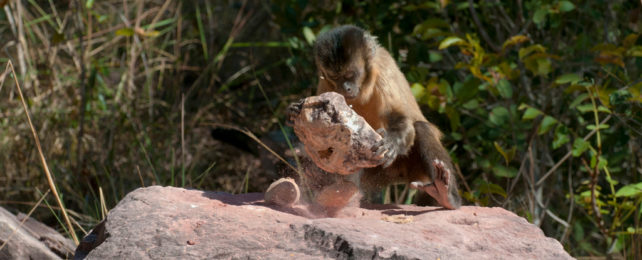Monkeys Accidentially Make Stone Tools Resembling Artifacts
March 12, 2023
In Southern Thailand, long-tailed macaques (Macaca fascicularis) monkeys use stones to mimic an anvil and hammer, breaking open hard nuts and shellfish for food. However, this process can inadvertently create rock flakes, resulting in what c
losely resembles other artifacts thought to be stone tools of early hominids. A study regarding this phenomenon was published in the journal titled Science Advances and has challenged several common perceptions of archaeologists in regard to ancient human life.
According to Jessica Thomspon, an uninvolved paleoanthropologist at Yale University, this discovery changes a whole lot, since essentially, “You have a bunch of nonhuman primates that are creating objects that look a lot like the kinds of things that we have wanted to exclusively assign to the behavior of humans and human ancestors.” Traditionally, stone tools resembling shards made by monkeys can date back to 3.3 million years ago, connecting to some key theories about human evolution and toolmaking. Now, scientists are presented with a new challenge of determining whether existing artifacts were intentionally created tools, or accidentally made rock shards.

However, even though animals in Thailand have been documented with these sharp rock shards, such creation, and usage of stone tools by any primate other than humans is quite rare. For instance, although some chimpanzees in West Africa use hammer stones and rocks akin to the macaques in Thailand, no stone flakes are left behind. Similar Capuchin monkeys in Brazil also have a record pounding nuts and seeds using stone hammers, leaving records resemblant to those in Thailand. With early hominid sites being discovered around the world, researchers have begun to inquire as to when humans actually entered the South American continent, since similarities between supposedly human artifacts and current monkey shards could mean 50,000-year-old sites were actually created by monkeys. While the monkeys don’t use the sharp edges as tools, as suggested by scientists in 2016, the sharp flakes accumulate to look like massive deposits of human stone tool artifacts.
As for the specific study on the long-tailed macaques in Thailand, the monkeys use stones to break oil palm nuts. Tomos Proffitt, a member of the Max Planck Institute for Evolutionary Anthropology, stated that “they put the oil palm nut on the anvil and use a hammer-stone in one or two hands,” according to NPR. Given that these nuts are hard, the monkeys hit them multiple times in a row, occasionally missing and hitting the hammerstone directly into the anvil. It is stones broken off this way that create shards. Proffitt has said that “As soon as a flake falls on the floor, it just stays there;” the monkeys don’t do anything with the potential tools.
Once the research team compared the stone pieces created by the macaques to artifacts from ancient hominid sites in Tanzania, Ethiopia, and Kenya, there was a lot of overlap between the two collections, although there were ways to distinguish between them. Aspects such as being surrounded by animal bones with apparent cut marks, modifications, or imported stones could indicate the intentional usage of tools. Similarly, looking at the core rock, archaeologists can see if there are patterns in the fracturing that were specifically targeted by the toolmaker. Given the difficulty of such determinations, it is possible that some artifacts could simply be mistakes, adding to the debate over a 3.3 million-year-old archaeological site in Kenya that has the potential to suggest earlier humans than those currently on record.
A final possible implication of these discoveries is that, while monkeys may be currently making tools by accident, humans could have followed a similar pattern, and then discovered they could use the rocks. According to David Braun, a George Washington University archaeologist interviewed by NPR, Chimpanzees, and similar primates have sharp teeth and thus don’t need knives. Yet, as humans evolved, brain size got larger tooth size shrunk, and therefore sharp rocks were necessary for food. Braun stated that “certainly [early humans] would have been producing them, or could have been producing them far earlier than they ever actually needed them,” suggesting that hominids realized the usefulness of stone shards and used them to their advantage once they had evolved to have smaller teeth.

















































![Image credit to [puamelia]](https://memorialswordandshield.com/wp-content/uploads/2025/08/3435027358_ef87531f0b_o-1200x803.jpg)


